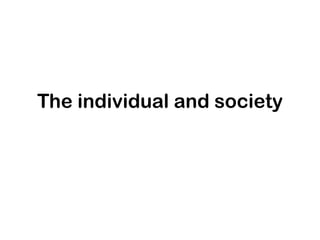
The individual and society
- 1. The individual and society
- 2. Nature vs Nurture • “How did I become who I am?” • Biological Determinism (Nature) • The idea that our biology and genetic makeup we inherit from our parents is mostly responsible for human behaviour and actions. • Social Determinism (Nurture) • The idea that culture and our social environment completely shape and influence human behaviour. • Sociologists do not like the term “Human nature” as it alludes to biological determinism.
- 3. How are individuals formed by Society? • Conceptions of Culture • Conceptions of the Self • Socialisation with others • Markers of identity: age, disability, ethnicity, gender, sexuality and social class • How we spend our work and free time
- 4. Who are you? • Task one: take a sheet of paper and head it ‘I am…’ complete the sentence in 10 different ways • Task two: in groups discuss your statements, compare similarities and differences. • Task three: How many of the statements for personal identity identify you as part of a group or in relationship to other people. What is the significance of this?
- 5. The Social Construction of Identity • Social Constructivism is an interactionist perspective that argues that things are constructed through cultural or social practice. • The markers of identity (age, disability, ethnicity, gender, sexuality and social class) are socially constructed. • What this means is that although these things have a biological basis, the meanings that surround them are constructed by social ideas.
- 6. Norms and Values • Culture is constructed of norms, values, customs, beliefs, knowledge, skills and language. • Sociologists believe that culture is not fixed, it varies from society and changes over time. • A norm tells us how to behave in particular situations. • Values provide general guides for how we should behave. • Norms and Values vary between different cultures and subcultures. Socialisation teaches us Norms and Values.
- 7. Socialisation • Socialisation is how we learn about society through interaction with society. • How do we interact with Society? • The agents of Socialisation: Family, Peer Groups, Media, Education and religion.
- 8. Primary Socialisation. • Primary socialisation is the way individuals interact with those they have a close, personal, intimate and face-to face relationship with. • The agents of primary socialisation are our parents/guardians and friends. • The places were we meet these agents of primary socialisation are called agencies of socialisation; the family, schools and the workplace.
- 9. Secondary Socialisation. • Secondary socialisation is the way individuals interact with those they do not have a close, personal, intimate and face-to face relationship with. • Secondary Socialisation is the way we learn about the social world beyond our primary contacts. • The agents of secondary socialisation are education, religion, mass media, the workplace and peer groups • Parsons said that secondary socialisation is there to “Liberate the individual from a dependence upon the primary attachments and relationships formed within the family group.”
- 10. Family Socialisation • A)In pairs, write down as many different toys and games as you can think of. • B) write 2 headings, ‘boys’ and ‘girls’ and put each toy or game under the heading you feel is most appropriate • C) do you feel it is natural for boys and girls to like different toys?
- 11. Ann Oakley – Family Socialisation • Ann Oakley found that children were encouraged to do certain things in order to socialise them into gender patterns. • Pink vs blue • Toys which encourage nurturing activities vs toys which encourage assertive behaviour. • Dolls vs ACTION FIGURES!!
- 12. Bordieu – The family and cultural capital • Bordieu discussed how cultural capital, tastes and habitus learnt from parents can give children certain advantages or disadvantages in the future. • An adherence to middle class tastes and habits allow for greater advantages in society and allow people to feel more comfortable in middle class locations.